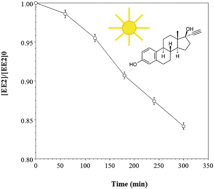Determination of estrogenic steroids and microbial and photochemical degradation of 17α-ethinylestradiol (EE2) in lake surface water, a case study
Abstract
In this study, a GC-MS technique was applied to determine 17α-ethinylestradiol (EE2), an active ingredient of oral contraceptives, and its fate in Lake Quinsigamond, Massachusetts, USA. To the knowledge of the authors, this is the first study of EE2 and its microbial and photochemical degradation in a lake ecosystem. EE2 was detected at a concentration up to 11.1 ng L−1. At this concentration EE2 may affect the reproduction of fish and other aquatic organisms in the lake due to its high estrogenic activity. EE2 was persistent to the biodegradation by the microorganisms in the lake. Under aerobic conditions a long lag phase (42 days) was observed before the biodegradation of EE2 and a half-life of 108 days was estimated. Under anaerobic conditions, EE2 experienced even a longer acclimation stage (63 days) and a slower microbial degradation in the lake water. The photodegradation of EE2 was rapid in the lake surface water under natural sunlight, with a half-life of less than 2 days in summer sunny days. Compared to biodegradation, photodegradation may represent a predominant removal mechanism for EE2 in natural surface waters.


 Please wait while we load your content...
Please wait while we load your content...